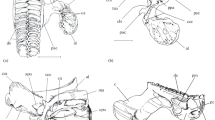Abstract
Japanese Aplysia kurodai feeds well on Ulva. In the present experiments we collected several species of seaweed at a location with many animals and initially explored the preference behavior for them. The animals rejected Grateloupia, Pachydictyon, Gelidium and Laurencia with rhythmic jaw and radula movements (active rejection). The animals sometimes bit off a piece of them (biting-off response). Recording activity of muscles contributing to jaw-opening and jaw-closing in freely moving animals showed that the onset of the jaw-closing activity, which always started later than the jaw-opening activity during each cycle of ingestion of Ulva, was advanced toward that of the jaw-opening activity during each cycle of the active rejection. Semi-intact experiments also showed that application of Pachydictyon or Gelidium extract to the lip region advanced the firing onset of the jaw-closing motor neurons at the radula-retraction phase. Video analysis showed that during the Ulva response the jaws opened at the radula-protraction phase and remained half-open at the earlier radula-retraction phase, while the jaws opened similarly at the radula-protraction phase but immediately closed at the radula-retraction phase during the Pachydictyon or Gelidium response.
Similar content being viewed by others
Author information
Authors and Affiliations
Additional information
Accepted: 8 October 1997
Rights and permissions
About this article
Cite this article
Nagahama, T., Shin, N. Patterned jaw movements and the motor neuron activity during rejection of seaweed in Aplysia kurodai. J Comp Physiol A 182, 551–562 (1998). https://doi.org/10.1007/s003590050202
Issue Date:
DOI: https://doi.org/10.1007/s003590050202



